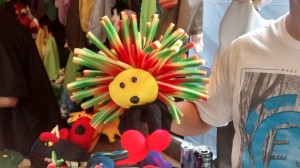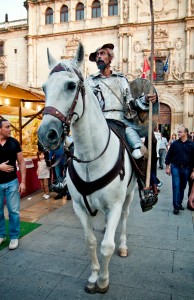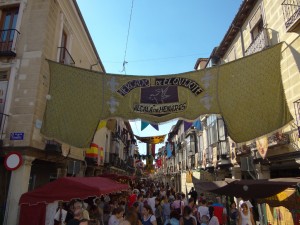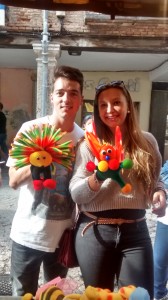Hello everybody!
We are Carolina and Miguel Ángel and as you know, last week was the Medieval Market in Alcalá de Henares. We love these days since Alcalá, for people who don’t know the city, dressed up to commemorate the baptism of Cervantes. We recommend you to visit it next year because there is a very friendly atmosphere and it is possible to learn many things about long time ago. In this market, you can find different handmade stands, animals such as predatory birds, donkeys or horses, troubadours or many different spectacles set in those times.
Making the most of the occasion, we would like to show you an interesting material we found there. There was a stand in which we realized there were a huge variety of puppets, all of them inspired in fantastic and real animals. But, what is our point of view of this material? Obviously, they can be used as a didactic source.

As all of you know, some weeks ago, we have talked about storytelling and how to do it successfully. These puppets can help us to carry it out and it is a fun resource for children.
These handcrafted animals do not cost a lot of money, however, we can make them in our own so they are even cheaper and have a personalized design. As we know, on the internet there are a lot of interesting webpages to make materials guided with really good scaffolding. So, why aren’t we creative and drive an initiative for our classrooms as teachers?
If you are interest on this, we were talking with the clerk and he explained to us how to do it by ourselves. Firstly and of course, we need the materials: they are made with foam rubber, a glove and paint cans or sprays. Then, the most important element they require is: CREATIVITY.

Finally, as we are imagination engineers, we can use this beautiful material as inspiration to create innovative ones, and after that, to use them not just in storytelling, but performances to develop different multiple intelligences, language skills, teamwork and cooperation, or every activity you imagine.
We hope you like it! Thank you ![]()



Hello Carol and Miguel,
I so much liked your post ^^. Sometimes we think that only books can help us to teach, and if fact anything can do, we just need to focus on the aims, and define well the procedures.
Taking advantage of children’s stages of development, where there is a time when they are able to assign human characteristics to objects, puppets can be used in the classroom as a way to present topics without feeling invasive to the children. One example can be found on the following link:
http://www.puppetsproject.co.uk/documents/puppets-t-earth-sci06.pdf
When looking for information about how to use a puppet in class, I found a really interesting website called Wonderful Teacher, where you can find a seven-point list of tips for teachers who want to use a puppet for their lessons. I summarize them below, and the whole post can be found at the following address:
http://wonderteacher.com/puppet-tips-for-teachers/
Basic Tips for Teaching with Puppet Power:
1- Start simply! First of all, use a silent mascot. It’s not necessary that it teaches from the beginning.
2- Practice with your puppet in a mirror. Better having two or three movements done perfectly, than a puppet difficult to manage that can not be used easily.
3- Plan a few gimmicks for your puppet. Give personality to the puppet. Find some things that it does frequently (covering the eyes, dropping things, laughing).
4- Keep the puppet “alive!” It the puppet is on the hand, it should do something. Otherwise, it’s time to go to sleep (to a bag, box, or drawer).
5- Choose puppets carefully. Think about the class and the things you want the puppet to help you with. It should be easy to use.
6- A response to “Is it real?” Think of the students’ developmental stage. Will they like the puppet, or think it too childish?.
7- Dealing with fear of puppets. Not every child likes puppets. Don’t force them to be near the puppet if they don’t like it.
Now is the time when I start thinking of the type of puppet I would have at my class. Would it be an animal, or a person? Would it talk a lot, or be quiet but a good observer that pays attention to the shier children? I cannot wait to have my own class and put it into practise, but…which one would you choose, Miguel and Carol?
Firstly, thank you for your post Loli, not only for commenting on it but also, for providing us with some useful tools we can take into account.
In my opinion, the personality of the puppet should depend on the course and the class we are. If our students are very talkative and naughty, we can have an observer puppet in our classrooms to reduce the noise in class, or maybe the opposite, our puppet can talk a lot to make them talk less.
But, I have something really clear: our puppet has to have a strong defined personality and also a context. If not, we, as teachers, are going to feel confused a lot of times because we are not going to know what to do and how to act with our puppet.
Anyway, puppets and fluffly toys could be important elements of our classrooms and we can use them didactically. (The stork house- classroom library).
Awesome post and add-up comment. Creating your own resources is always fantastic, but it is also agreat opportunity to help children create their own characters who, surprisingly, can only speak English! ^^